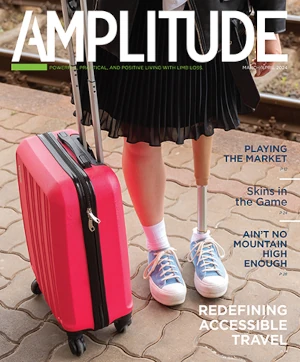In a scientific collaboration between the École Polytechnique Fédérale de Lausanne (EPFL), Switzerland, and Scuola Superiore Sant’Anna, Pisa, Italy, researchers combined virtual reality and artificial tactile sensations to allow two people with amputations to feel as though their prosthetic hands belonged to their bodies. The results were published August 15 in the Journal of Neurology, Neurosurgery & Psychiatry. “The brain regularly uses its senses to evaluate what belongs to the body and what is external to the body. We showed exactly how vision and touch can be combined to trick the amputee’s brain into feeling what it sees, inducing embodiment of the prosthetic hand with an additional effect that the phantom limb grows into the prosthetic one,” said Giulio Rognini, PhD, from EPFL’s Laboratory of Cognitive Neuroprosthetics. “The setup is portable and could one day be turned into a therapy to help patients embody their prosthetic limb permanently.”
The participants each had a left transradial amputation and were given transverse intrafascicular multichannel electrode (TIMEs) implants. The scientists provided artificial tactile sensations by stimulating nerves in each participant’s residual limb that related to the tip of his index finger. At the same time, the patient wore virtual reality goggles that showed the index finger of the prosthetic limb glowing as the touch sensations were administered.
Both patients reported feeling as though their prosthetic hands belonged to their bodies. Moreover, when asked to evaluate the position of their hands, both patients felt as though their phantom limbs had extended into the prosthetic limbs. Before the experiment, they reported that the phantom hand was small and directly connected to the residual limb, as if the phantom limb had no forearm, referred to as telescoping. During the experiment, they said they felt their phantom limbs had extended and remained extended for up to ten minutes afterwards.
The experiment required the patient to passively observe two sensations on the fingertip, the visual glow and the artificial touch happening in synchrony, in order for embodiment and extension of the phantom limb to take place. EPFL says this is the first time that the principles of multisensory integration, in particular how the brain integrates bodily multisensory information to create the coherent and compelling experience of having a body, have been tailored to provoke embodiment of the prosthetic hand and reduction of telescoping.
The study builds upon research led by EPFL that began in 2014, in which scientists were able to provide real-time bidirectional sensory perception to Dennis Aabo Sørensen, who also has a left transradial amputation. In 2016, Sørensen was able to detect differences in texture by using the enhanced technology.
Editor’s note: This story was adapted from materials provided by École Polytechnique Fédérale de Lausanne.



